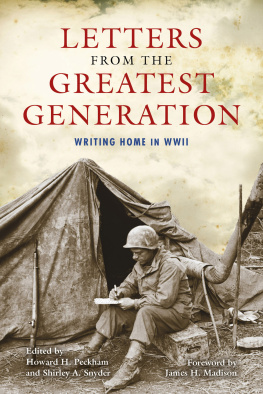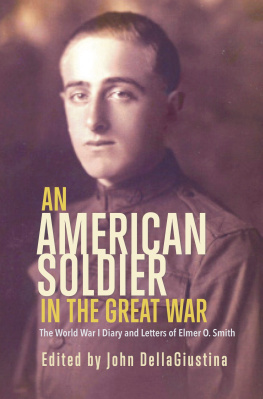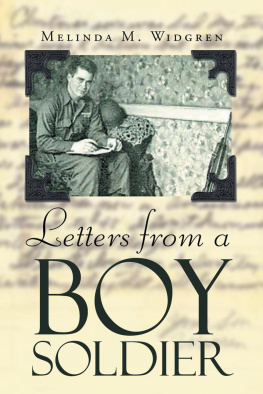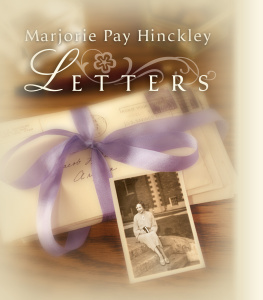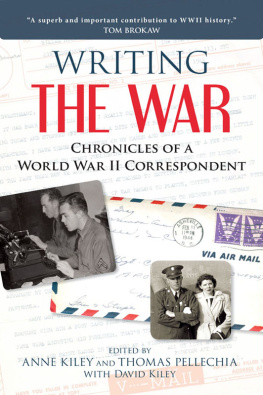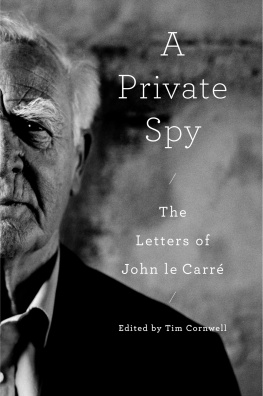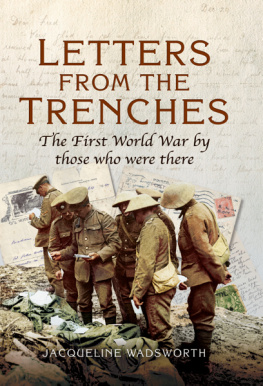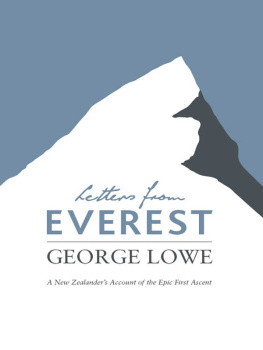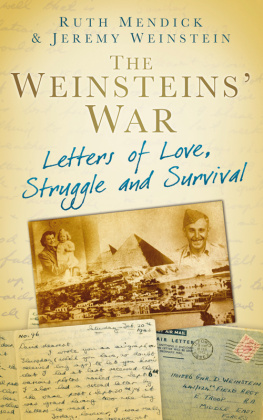
LETTERS FROM THE GREATEST GENERATION
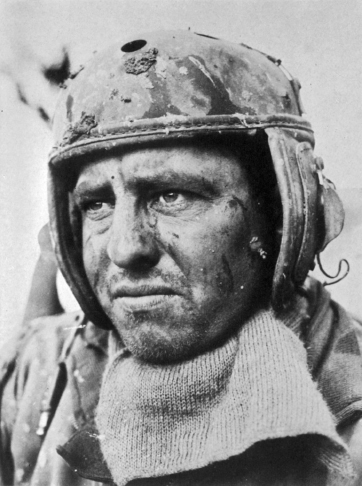
Signal Corps photo from Acme
Sgt. John H. Parks, of Mill Creek, Indiana, was voted the Man of the Year by his fellow G.I.s in the European theater of operations because his appearance typified the war-weary soldier. As winner of this distinction, his picture appeared in Stars and Stripes, Dec. 22, 1944. The next day, the twenty-three-year-old tank man was killed in Luxembourg.
LETTERS
FROM THE
GREATEST GENERATION
WRITING HOME IN WWII
Edited by
HOWARD H. PECKHAM & SHIRLEY A. SNYDER
Foreword by
JAMES H. MADISON
INDIANA UNIVERSITY PRESS
Bloomington and Indianapolis
Originally published as Letters from Fighting Hoosiers by Howard H. Peckham and Shirley A. Snyder, Indiana War History Commission, 1948.
This book is a publication of
Indiana University Press
Office of Scholarly Publishing
Herman B Wells Library 350
1320 East 10th Street
Bloomington, Indiana 47405 USA
iupress.indiana.edu
2016 by Indiana University Press
All rights reserved
No part of this book may be reproduced or utilized in any form or by any means, electronic or mechanical, including photocopying and recording, or by any information storage and retrieval system, without permission in writing from the publisher. The Association of American University Presses Resolution on Permissions constitutes the only exception to this prohibition.
The paper used in this publication meets the minimum requirements of the American National Standard for Information SciencesPermanence of Paper for Printed Library Materials, ANSI Z39.481992.
Manufactured in the United States of America
Library of Congress Cataloging-in-Publication Data
Names: Peckham, Howard Henry, editor | Snyder, Shirley A., editor.
Title: Letters from the greatest generation : writing home in WWII / edited by Howard H. Peckham and Shirley A. Snyder ; foreword by James H. Madison.
Other titles: Letters from fighting Hoosiers
Description: Bloomington : Indiana University Press, 2016. | Includes index. | Originally published as Letters from Fighting Hoosiers by Howard H. Peckham and Shirley A. Snyder, Indiana War History Commission, 1948.
Identifiers: LCCN 2016019849 (print) | LCCN 2016021072 (ebook) | ISBN 9780253024480 (print : alk. paper) | ISBN 9780253024602 (ebook)
Subjects: LCSH: World War, 1939-1945Personal narratives, American. | SoldiersUnited StatesCorrespondence.
Classification: LCC D769 .L45 2016 (print) | LCC D769 (ebook) | DDC 940.54/8173dc23
LC record available at https://lccn.loc.gov/2016019849
1 2 3 4 5 20 19 18 17 16
CONTENTS
FOREWORD
Here are the voices of fighting Hoosiers, the women and men who served overseas in World War II. Their letters home range from sophisticated insights to the tiny details of everyday life. They wrote of planes over Pearl Harbor whipping down on us with the red sun of Japan on each wing tip, of the Normandy beaches and hedgerowssimply a bad place, and of the kamikaze attacks off Okinawa where they just sweated it out. Here are firsthand, moving accounts of war.
World War II was the bloodiest war in human history. Letters home tended to be positive and hopeful, yet through them, twenty-first-century readers can still glimpse the brutality, which was not reported in newspapers at the time and was not always present in later public memories. There are vivid descriptions of the dead, including friends and comrades, and laments of rain and mud, cold and heat, the weeks without a change of clothing, the weariness of combat. Often it is the small things that stand out, as when Ernest Ellett told his parents a month after Nazi surrender that he was now gaining back the twenty pounds lost in combat.
Most of these writers were young, homesick Hoosiers. Many had not traveled outside Indiana, and their longing for family and home runs deep. Ill bet Im the only person in Decatur who has flown across the Atlantic, Jim Christen wrote from North Africa, as he asked his mother for news from the little old town. Jim Rosenbarger regretted that he had not received a copy of the Corydon Democrat since arriving in France.
One reason soldiers picked up their pens was to encourage responses from home. The mail they received was an essential morale booster in an age before long-distance telephones and electronic communication. Complaints about not receiving letters were commonplace. Frank Woltman grumbled about slow mail but admitted that he had received twenty-three cards and letters in the two weeks after Christmas 1943. The American military was keenly aware of the importance of mail and worked hard to speed the flow. Improvement came with V-mail, short for Victory Mail, a process that photographed letters onto reels of microfilm. The reels were flown quickly overseas, where they were printed onto photographic paper and delivered to recipients. War propaganda posters encouraged home front and overseas correspondents to use V-mail and to write frequently. They didsoldiers received more than a billion V-mail letters.
While some letters were written in the voice of a loved one talking quietly in the kitchen or front room, censorship stood in the way of frank conversation. I cant say anything about our engagements. The censor would just mark it out, Vernon Hobbs Jr. wrote from the Philippines to his parents. From the South Pacific, Charles Putnam Jr. lamented that he couldnt write anything at all except, Hello, Im fine, goodbye. Military men and women also self-censored not only to meet regulations but to spare loved ones the worst of horrors. Even love letters were often restrained. Writers also seldom noted instances of bad behavior by Americans. Historians now know that life overseas included drunkenness, sexual promiscuity, crime, and frequent use of profanity, with chickenshit and the f-word commonly deployed. These features of war were only hinted at, as in Red Cross volunteer Mary Sinclairs comment that there were many wild raucous youths in the army. A leave to liberated Paris tended to elicit racy observations. For instance, Karl Price reported seeing nude female dancers in a city that holds honors when it comes to immorality.
There were traces, too, of Hoosier modesty. A. Ebner Blatts description of parachuting with the 101st Airborne on the night before D-day was straightforward and full of telling details, though he did not boast of the genuine heroism and courage that we now know marked the Normandy landings. Similar was Kathryn Snyders humorous description of abandoning a sinking ship with fellow nurses who used their helmets to bail out the lifeboat.
Some of the letters have sophisticated literary qualities. Thats certainly true of the two examples of Ernie Pyles writing included in this volume. World War IIs greatest American correspondent penned a superb sketch of Tommy Clayton from Evansville with the accumulated blur, and the hurting vagueness of being too long in the lines, the everlasting alertness, the noise and fear. Ordinary writers sometimes came close to Pyle.
The Indiana War History Commission gathered and published these letters as part of a cooperative endeavor organized in 1942 by the Indiana University Department of History and the Indiana Historical Bureau to explore sources of both military and civilian life. The commissions work is an outstanding example of contemporary history that looked forward to the needs of future generations.
Next page
